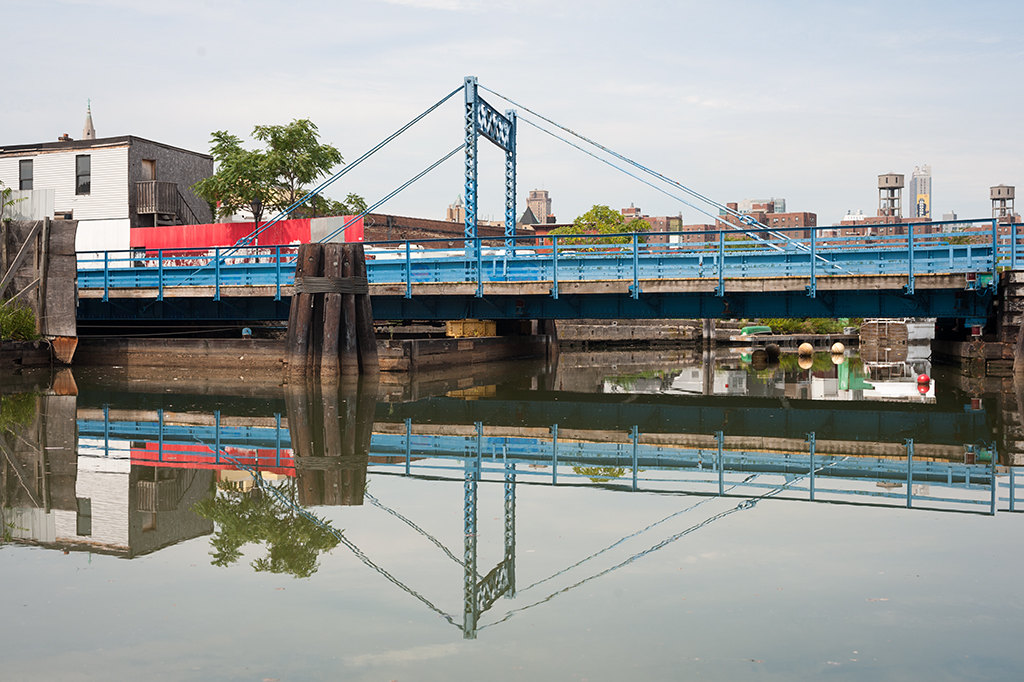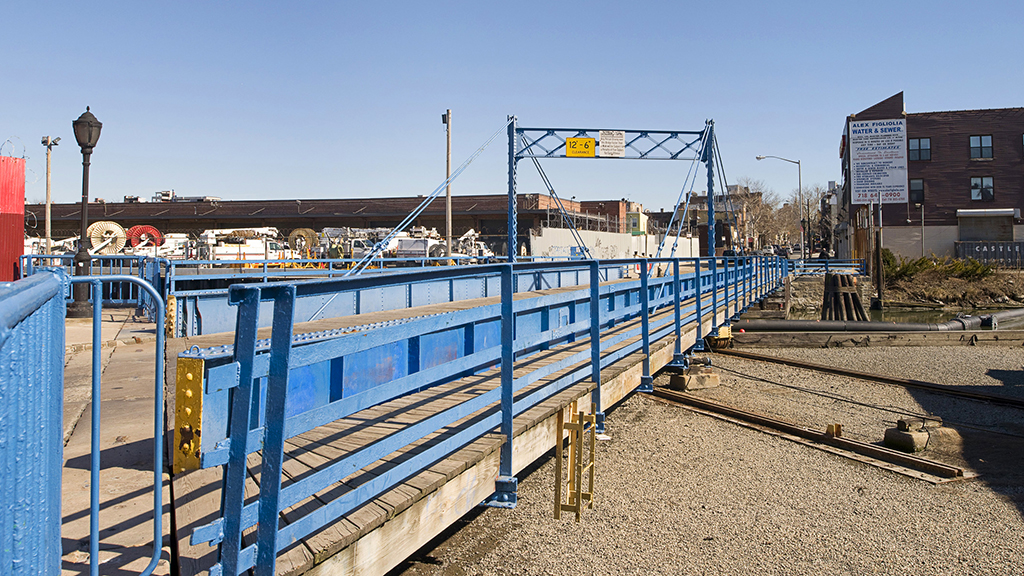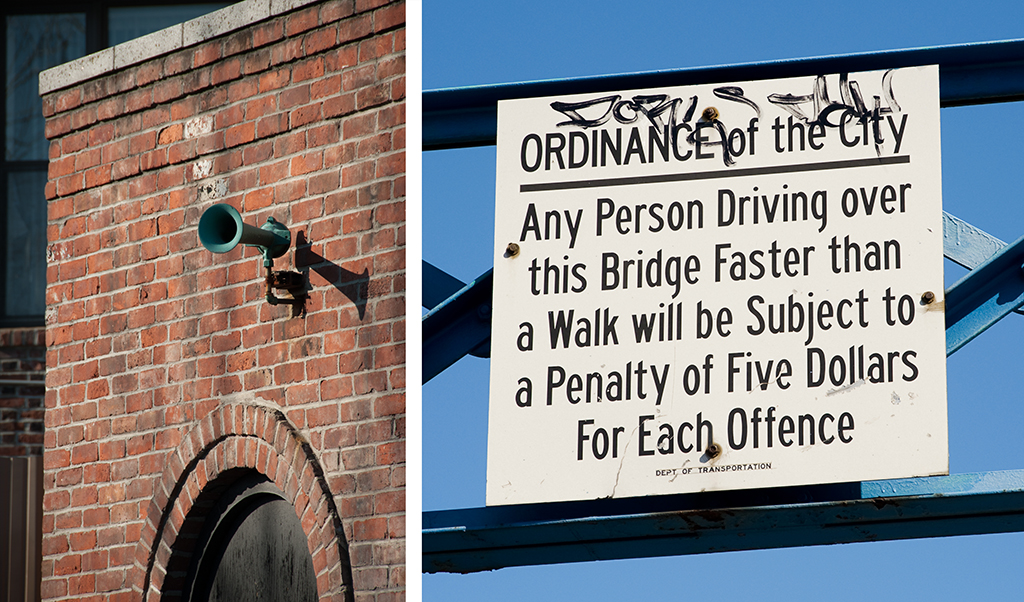
Crosses: Gowanus Canal
Connects: Carroll Gardens and Park Slope, Brooklyn, NY [satellite map]
Carries: 1 vehicular lane, 2 sidewalks
Design: retractile
Date opened: 1889
The Carroll Street Bridge is a retractile drawbridge that crosses the Gowanus Canal in the borough of Brooklyn. It is notable as the oldest surviving retractile bridge in the United States, with only three others still in existence: two non-operational draws in Boston, and one carrying Borden Avenue over Dutch Kills in the borough of Queens.

Planning and Construction
The bridge was built between 1888-1889 by the New Jersey Steel & Iron Company. It replaced a wooden swing bridge that had become so rotten over the years that city engineers were forced to close it in early 1887 to everything but pedestrian traffic, fearing it would collapse under anything heavier. The Brooklyn Common Council passed a resolution in July 1888 ordering that $1200 be allocated for the repair of the bridge. Brooklyn Mayor Alfred Chapin, following the advice of city engineers who felt that repairs would be useless on such a deteriorated structure, vetoed the resolution and instituted a tax levy that would raise $40,000 to pay for a replacement structure.
Plans for the new bridge were developed soon after. George Ingram and Robert Van Buren, engineers with the Department of City Works preferred a retractile bridge to replace the old swing span, as did local property owners. In September 1888 the old bridge was removed, and a public auction was announced for the sale of the superstructure. Construction of the new one was begun at the end of the year. It opened in September the following year, completed at a cost of $29,600.
Rehabilitation and Landmarking
By the 1980s, the bridge had fallen victim to the city’s deferred maintenance program. The Department of Transportation closed the bridge in 1985 after an inspection revealed multiple holes in the road deck, seriously corroded steel, and a broken operating mechanism. After a $1.5 million overhaul by city workers, the bridge was able to reopen to traffic just in time for the 100th anniversary of its initial opening in 1989.

As a retractile draw, the bridge opens by physically sliding out of the navigation channel on a set of three steel rails, pulled by an electrically operated pulley system. The moving portion of the bridge is a 107-foot long trapezoidal deck, supported in the middle by an iron post-and-truss frame that gives the superstructure the appearance of a suspension bridge. The operating controls for the bridge are located in a polygonal brick house on the west side of the site. The house was built during the bridge’s overhaul project of bricks salvaged from the demolition of the old operating house. One of the more interesting features of the bridge, a sign threatening a five dollar fine for anyone driving over the bridge faster than a walker’s pace, was also added during the overhaul.
The unique style of the this bridge gained it landmark status in 1987, with the Landmarks Preservation Commission citing its “rare and unusual” qualities. This designation is meant to preserve the historical nature of the bridge from being altered without the Commission’s approval.
– – – – – –
References
1888, July 22. A rotten bridge. Brooklyn Daily Eagle. Retrieved from: eagle.brooklynpubliclibrary.org
1888, September 10. Notice of sale of Carroll Street Bridge. Brooklyn Daily Eagle. Retrieved from: eagle.brooklynpubliclibrary.org
1889, September 26. Work on the Carroll Street Bridge completed. Brooklyn Daily Eagle. Retrieved from: eagle.brooklynpubliclibrary.org
1987. Carroll Street Bridge Over the Gowanus Canal, Borough of Brooklyn, built 1888-1889 … [report]. Landmarks Preservation Commission. New York: Landmarks Preservation Commission. Retrieved from: neighborhoodpreservationcenter.org
1989, May 21. Gray, Christopher. Getting a landmark in shape for its 100th birthday. New York Times, p. R12. Retrieved from: nytimes.com
1989, September 24. Pitt, David E. Two neighborhoods celebrate restoration of their bridge. New York Times, p. 40. Retrieved from: nytimes.com
1989, September 29. Bringing back the bridges. New York Times, p. A34. Retrieved from: nytimes.com
Update:
In April 2013, the Carroll Street Bridge closed to traffic in order to undergo rehabilitation, which includes “replacement of the deteriorated timber deck; restoration of expansion joints; replacment of impacted stiffeners, angles and plates, cleaning and painting structural steel at deterioration locations; resetting
roadway paving units at west abutment; sidewalks repairs; installation of new timber curbs and rubber dock fenders” (http://www.brooklyncb6.org/_attachments/2013-04-01%20DOT%20Carroll%20Street%20Bridge.pdf); work is expected to be completed in August, 2013.
A photo of the bridge during the early stages of rehabilitation can be seen here: http://www.flickr.com/photos/jeffs4653/8634711198/